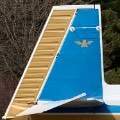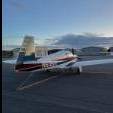All Activity
- Past hour
-
Wild ride takeoff roll and landing roll
PT20J replied to mpilot's topic in Vintage Mooneys (pre-J models)
Lost motion due to wear in the steering linkages will make precise steering more difficult because it introduces a dead zone between left and right pedal inputs. This is most noticeable at taxi speeds. Failure to track straight at higher speeds is a caster angle issue and that’s what the service bulletin addresses. -
are there 3D-printed brackets for our sun-visor available?
hazek replied to NicoN's topic in Modern Mooney Discussion
I could use a couple too. -
Here's an example of a Mooney M20F that checks all your boxes that is priced at $164k: https://www.trade-a-plane.com/search?category_level1=Single+Engine+Piston&make=MOONEY&model=M20F+EXEC+21&listing_id=2448117&s-type=aircraft . M20J with a KAP-150 AP but otherwise what you want for $175k: https://www.trade-a-plane.com/search?category_level1=Single+Engine+Piston&make=MOONEY&model=M20J+201&listing_id=2446676&s-type=aircraft M20E with your panel and mid-time engine for $110k: https://www.trade-a-plane.com/search?category_level1=Single+Engine+Piston&make=MOONEY&model=M20E&listing_id=2444592&s-type=aircraft Current market dynamics inform prices. There's some leeway there, but that's just what it is .
-
Wild ride takeoff roll and landing roll
Kelpro999 replied to mpilot's topic in Vintage Mooneys (pre-J models)
These bolts left and right should be checked through the exhaust cavities. Being loose adds to excessive rudder pedal looseness. Tightening them will test your tool modifying ability. -
@CFIcare A few thoughts for you on this journey: The 1950s Bonanzas are underpowered and have convoluted fuel systems requiring careful management. They will cruise around 140kts at a higher fuel burn than the Mooney. That's why they command such a comparatively low purchase price when comparing to the 1960s and above V35 Bonanzas. It does not mean it's a dealbreaker, only that you have to stay on top of the fuel system and get well-trained by someone who knows the airplane. You will not find what you're looking for for $100k, as you've already seen on the market. $120k will step you up into a nice C model, an E or an F with a compromise. You will not get a J in this price range with what you're looking for, that would be closer to $170-180k for a J with these specs. I have been in 3 airplanes in the last 6 months doing transition training that had panels and engine times you described, 2 Fs and an E, that were recently purchased. Both Fs were in the $140-155k range, the E was in the $170k range. They also had speed mods and the E was basically perfect (speed mods, interior, paint, engine, panel, etc.). You're asking for a plane at the top of the market: good engine, top of the line modern panel, so you need to be ready to pay top of the market prices, or slim your list down to match your budget. I would budget $130k for a C, $150k for an E or an F for what you're wanting to find. Hopefully you will find one for less than that, but if you don't want to change your wish list, that's what you need to be ready for. I've owned Mooneys for the better part of the last 10 years. I've never had a grounding parts issue. I have had to replace the dreaded intake boot, but I was able to find one, and now I have a backup one I bought from LASAR when they did their last run. Parts availability is better on the Bonanzas, but also much more expensive. If you want to buy a plane to immediately fly the crap out of it, don't buy one with a run-out engine. The wait is 6-8 months to get it overhauled. Avionics work will probably be around 2-3 months, but will cost more, especially with a primary engine monitor and a GFC-500 ($20-25k install). If you are sold on the primary engine monitor, I highly recommend also looking for one that has CIES Fuel Senders, you can't really effectively stick the tanks in Mooneys past a certain fuel level and with inaccurate gauges you won't know how much fuel is in your airplane! For a 4-seat, fast, glass-panel, autopilot airplane, your options are really Mooney, Bonanza, Cirrus, Comanche, Rockwell Commander, Super Viking, or Experimental but 4-seat experimentals are equally pricey to obtain and harder to find. The Mooney is the cheapest price-wise of that group. Each has their pros and cons.
-

Cirrus training CAPS use rationale
Pinecone replied to Rick Junkin's topic in Miscellaneous Aviation Talk
From what I remember, before the training people were NOT using CAPS. That training was to get people to actually use it and THAT reduced the fatality rate. -
Going back to the OP's posting, and with the caveat that without pictures it is much harder to assess paint and interior condition, I would guess that the plane as described should fetch around $75-80k in a private party sale, perhaps a bit more if Jimmy Garrison was selling it. I am calculating this against my own plane which I think would normally sell for around $75k (1970 E with 650 hours on a good overhaul with new cylinders). -- The one the OP is selling has a lower timed engine from a reputable shop so that would count for more, maybe +$10k. -- No autopilot and no engine monitor lower the value, at least for me they are a must -- -$10k (50% of cost to install new ones) -- I don't know how to price the Rayjay turbo -- I'm sure it is great for high altitude takeoffs (not important for me as a low-lander), and probably gets you higher speeds at altitude, but at the expense of more maintenance -- $0 -- There is no mention on high cost items like tank reseals, landing gear shock disks; any damage history; hours flown in the last 2/5/10 years? I did not put a value on this, but this could add or subtract quite a bit.
- Today
-

CO2 detectors the "Good The Bad and The Ugly
Pinecone replied to Jpravi8tor's topic in Vintage Mooneys (pre-J models)
There is a point that in most cases the meter 0 is set to ambient air. And ambient air could have up to 1 PPM CO. So your 0 reading on your meter is not really ZERO CO. When I did this for a living, we used two tanks of gases to CAL and SPAN our meters. One was REALLY 0 PPM CO, and the other was some level depending on the range you were expecting. In that case, 0 is really ZERO. But for all practical purposes, 0 on your portable meter is at or below the ambient air. SO unless you turn it one in a location with high CO levels, the number is close enough to 0 to be treated as 0. -
There is a difference between what you can sell your plane for and what you should insure it for. Remember, if you have a mishap, if the repair cost is over about 70% of the insured value you will have a check, not an airplane. And with current costs, a gear up could end up with your plane being totaled. And you get to start looking for a new plane.
-
hose for Brittain TC and servo valve?
AJ88V replied to AJ88V's topic in Vintage Mooneys (pre-J models)
Hope to dig into it today. I only looked from beneath the panel, not from the top through the avionics access panels on the cowling. Hopefully it will be way easier to get to from the top!!! -
But it was considered "normal" to have steam gauges fail or the vacuum pump fail and have to be replaced or repaired/rebuilt
-
are there 3D-printed brackets for our sun-visor available?
Fly Boomer replied to NicoN's topic in Modern Mooney Discussion
I do not know what models @DonMuncy makes them for, but he may be able to help. -

Cirrus training CAPS use rationale
Jerry 5TJ replied to Rick Junkin's topic in Miscellaneous Aviation Talk
Speaking of myself in the instructor role, your quote is truncated. I say “it’s is the insurance company’s plane if the engine quits: Don’t try to save the aluminum, just protect the people.” -
Wild ride takeoff roll and landing roll
skykrawler replied to mpilot's topic in Vintage Mooneys (pre-J models)
It could be the nose steering on takeoff is more sensitive than what you are used to. The pressure and movements are small. It more like leaning on it rather than steering. You get the same affect on many airplanes if you are two aggressive with nosewheel steering. Clumsy feet can make a King Air dart around. -
NicoN started following are there 3D-printed brackets for our sun-visor available?
-

Wild ride takeoff roll and landing roll
Cfidave replied to mpilot's topic in Vintage Mooneys (pre-J models)
As the article states, this spacer will fix a " dart to the left". Old pucks won't cause that to the extent a bad nose wheel alignment will. Before I installed the spacer my plane would head left in a hurry after landing, the higher the speed the more it would dart left. The spacer fixed that issue and my nosewheel pucks are older then yours. -

Wild ride takeoff roll and landing roll
Cfidave replied to mpilot's topic in Vintage Mooneys (pre-J models)
Did you click on this? https://lasar.com/service-bulletin-kits/service-bulletin-kit-tracking-spacer-m20-202-001 -
Looking for Paint Color on this plane (N1336W)
Matthew P replied to Matthew P's topic in Vintage Mooneys (pre-J models)
Thanks -
CO2 detectors the "Good The Bad and The Ugly
MikeOH replied to Jpravi8tor's topic in Vintage Mooneys (pre-J models)
Not much difference when in a PROPERLY functioning cabin behind said inefficient piston engine. No where am I arguing that the ENGINE doesn't emit CO. No clue why you would think that?? -
CO2 detectors the "Good The Bad and The Ugly
Justin Schmidt replied to Jpravi8tor's topic in Vintage Mooneys (pre-J models)
You laying down in the middle of the road in nyc. In my area (cincinnati) CO is below detectable amounts <1ppm. I'm sure a very expensive large lab equipment that uses NDIR or Laser you can detect some. Can i ask, does this CO of yours have a can or bottle shape, -

Cirrus training CAPS use rationale
Jackk replied to Rick Junkin's topic in Miscellaneous Aviation Talk
Unlike the others, cirrus marketed the crap out of their parachute gizmo, selling “safety” -

CO2 detectors the "Good The Bad and The Ugly
Jackk replied to Jpravi8tor's topic in Vintage Mooneys (pre-J models)
So flying behind a giant inefficient piston engine you have less PPM than walking down a sidewalk? -
Elevator bungee springs
Justin Schmidt replied to cruiserflyer's topic in Vintage Mooneys (pre-J models)
At least that one you know something incredibly stupid BUT fun and hilarious is about to happen -
Yuup! Right up there with, "Hold my beer, and watch this!"
-
Elevator bungee springs
Justin Schmidt replied to cruiserflyer's topic in Vintage Mooneys (pre-J models)
Famous words that has been a top killer of people throughout civilization.




